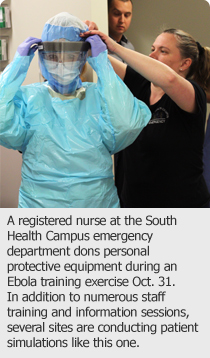
November 4, 2014
Story and Photo by Colin Zak
An actor posing as a patient walks into the emergency department at South Health Campus, claiming he recently returned from West Africa and has influenza-like symptoms.
The triage team – unaware this ‘patient’ is an actor – launches into action.
The training exercise has begun.
South Health Campus conducted its second live scenario Ebola virus disease (EVD) training exercise Oct. 31 as part of ongoing provincial EVD preparedness efforts.
“The goal of the exercise is to ensure our health care teams know how to react in the unlikely event that we get a case of Ebola in our province. It involves co-ordinating a number of teams, from emergency department staff, to laboratory services, to cleaning and maintenance staff,” says Dr. Francois Belanger, Alberta Health Services’ Vice President and Medical Director, Central and Southern Alberta.
“This is about ensuring we are prepared to care for the patient, prevent spread of the disease and ensure our staff, physicians and all patients are safe and secure.”
Although the risk of Ebola in Alberta remains very low, AHS is prepared to protect the health of Albertans, with procedures and precautions in place, staff training and simulations.
There are currently four designated Ebola treatment sites across the province: South Health Campus and Alberta Children’s Hospital in Calgary, University of Alberta Hospital and the Stollery Children’s Hospital in Edmonton. In addition to numerous tabletop exercises, several sites are conducting Ebola patient simulations like this one.
“Training scenarios like these give staff the opportunity to put theory into practise before they encounter a patient in real life,” says Lori Anderson, Senior Operating Officer of South Health Campus. “We can evaluate our planning and see how staff react by simulating a real-life scenario. We incorporate teaching throughout the exercise and incorporate the valuable learning and insights from the training scenarios into our planning and practice.”
After the emergency department triage team identified the patient actor as a possible case of EVD, the ‘patient’ was immediately brought to an isolation room in the emergency department. Within one hour of walking through the door, the patient actor was in a specialized isolation room at the facility’s intensive care unit (ICU).
Nurses and physicians wore all required personal protective equipment (PPE).
“Patients with Ebola need to be cared for using very specific and highly specialized procedures,” says Dr. Belanger. “Protective wear must be donned and removed with the help of another health care staff. Simulation scenarios and other training sessions are designed to familiarize staff with the meticulous steps and details involved in keeping themselves and patients safe.”
Along with comprehensive guidelines and protocols developed and in place, training and practise opportunities continue to be offered to AHS staff and physicians across the province, including hands-on training with protective equipment, general education and theory, demonstrations and Q & A sessions.
Though training is prioritized to ‘at-risk’ groups including physicians, Emergency Medical Services staff, emergency department staff, and critical care staff, provincial information and practice sessions are being offered to all AHS staff.
In October alone, more than 200 Ebola education and training sessions have been offered to staff. Additional sessions are planned for the weeks to come.